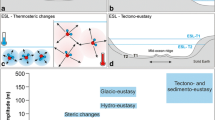Abstract
The main stage of a modern approach to calculating the wave climate includes the creation of a sea state database based on hydrodynamic modeling. The input data for retrospective calculations are wind information available in the global hydrometeorological data reanalysis. This reanalysis, especially when reproducing the extreme statistics of the wave mode, should be adjusted in light of the regional characteristics of atmospheric processes. The specifics of any waters require a priori adaptation of hydrodynamic models to specific conditions, the results of which are checked by comparing model calculations with field observation data. The calculation results for the hydrodynamic model are summarized using a set of probabilistic models of different classes.





Similar content being viewed by others
REFERENCES
S. A. Ambrosimov and E. S. Ambrosimov, “Wind waving in the central part of Caspian Sea,” Inzh. Fiz., No. 6, 41–47 (2007).
A. V. Bukhanovskii, L. I. Lopatukhin, E. S. Chernysheva, and A. M. Kolesov, “Storm in the Black Sea on Novemebr 11, 2007 and statistics of extreme sea storms,” Izv. Russ. Geogr. O-va, No. 2, 71–84 (2009).
A. V. Bukhanovskii, L. I. Lopatukhin, and E. S. Chernysheva, “New generation of the handbooks of sea waving regimes,” Nauchno-Tekh. Sb. Ross. Morsk. Reg. Sudokhodstva, No. 34, 50–65 (2011).
Wind and Waves in the Oceans and Seas: Handbook Ed. by I. N. Davidan (Transport, Leningrad, 1974) [in Russian].
Water Balance and Level Fluctuations in the Caspian Sea: Modeling and Forecast (Triada LTD, Moscow, 2016) [in Russian].
Hydrometeorology and Hydrochemistry of the Seas, Vol. 6: The Caspian Sea, No. 1: Hydrometeorological Conditions, Ed. by F. S. Terziev (Gidrometeoizdat, St. Petersburg, 1992) [in Russian].
L. I. Lopatukhin, “The maps of waves of the Caspian Sea,” in Hydrometeorological Maps of the Caspian Sea (Department of Navigation and Oceanography, Ministry of Defence of USSR, Leningrad, 1988) [in Russian].
L. I. Lopatukhin, A. V. Bukhanovskii, A. B. Degtyarev, and V. A. Rozhkov, Reference Data on Regime of Wind and Waves in Barents, Okhotsk, and Caspian Seas (Russian Maritime Register of Shipping, St. Petersburg, 2003) [in Russian].
L. I. Lopatukhin, A. V. Bukhanovskii, E. S. Chernysheva, et al., “New generation of the handbooks and information materials on the sea dynamics (to the decade of implementation of the concept published in research works of RAO,” in Proceedings of Ninth International Conference RAO/CIS Offshore 2009 “Exploration of Arctic Sea Shelves” (RESTEC Exhibition Company, St. Petersburg, 2009), Vol. 2, pp. 40–45.
A. A. Magaeva, N. A. Yaitskaya, N. V. Likhtanskaya, and L. V. Dashkevich, “Development of GIS system of glacial regime of the southern seas of Russia,” Ekol., Ekon., Inf. 3, 269–275 (2015).
N. A. Yaitskaya, Candidate’s Dissertation in Geography (Murmansk, 2012).
N. A. Yaitskaya and V. V. Loshchinskaya, “Creation of GIS system of the southern Russian seas for storage of historical cartographic information,” Ekol., Ekon., Inf. 2, 211–217 (2013).
S. Berdnikov, N. Yaitskaya, and Yu. Lychagina, “The study of ice conditions of the Caspian Sea using satellite monitoring data (2008–2011),” in Proceedings of the Fourth International Conference on Environmental Management, Engineering, Planning and Economics (CEMEPE 2013) and SECOTOX Conference (Grafima, Thessaloniki, 2013).
C. Graham, V. J. Cardone, E. A. Ceccacci, et al., “Challenges to wave hindcasting in the Caspian Sea,” in Proceedings of the 7th International Workshop on Wave Hindcasting and Forecasting (Banff, 2002).
E. Kalnay, M. Kanamitsu, R. Kistler, et al., “The NCEP/NCAR 40-year reanalysis project,” Bull. Am. Meteorol. Soc. 77, 437–470 (1996).
L. J. Lopatoukhin, A. V. Boukhanovsky, E. S. Chernysheva, and S. V. Ivanov, “Hindcasting of Wind and Wave Climate of Seas Around Russia,” in Proceedings of the 8th International Workshop on Wave Hindcasting and Forecasting (Downsview, 2004).
SWAN. Technical Documentation (Delft University of Technology, 2006).
N. Yaitskaya, Y. Lychagina, and S. Berdnikov, “The ice conditions study of the Caspian Sea during the winter periods 2008–2010 using satellite monitoring data and geographical information system,” Fresenius Environ. Bull. 23 (11), 2771–2777 (2014).
ACKNOWLEDGMENTS
The study was carried out with the financial support of the Russian Foundation for Basic Research (project nos. 16-35-50079 mol_nr and 16-35-60046 mol_a_dk) and the Russian Geographic Society (project no. 17-05-41190 RGO_a).
Author information
Authors and Affiliations
Corresponding author
Additional information
Translated by G. Karabyshev
Rights and permissions
About this article
Cite this article
Lopatoukhin, L.I., Yaitskaya, N.A. Wave Climate of the Caspian Sea, Input Wind Data for Hydrodynamic Modeling, and Some Calculation Results. Oceanology 59, 7–16 (2019). https://doi.org/10.1134/S0001437019010120
Received:
Accepted:
Published:
Issue Date:
DOI: https://doi.org/10.1134/S0001437019010120




